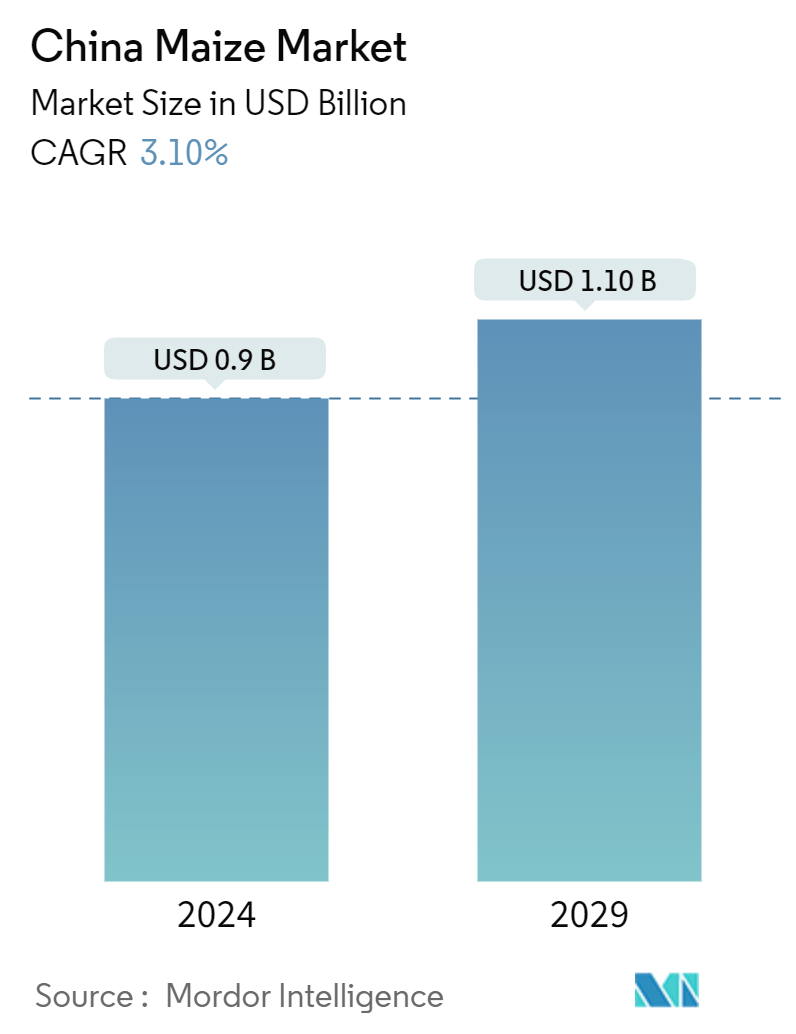Market Size of China Maize Industry

| Study Period | 2019 - 2029 |
| Base Year For Estimation | 2023 |
| Forecast Data Period | 2024 - 2029 |
| Market Size (2024) | USD 0.9 Billion |
| Market Size (2029) | USD 1.10 Billion |
| CAGR (2024 - 2029) | 3.10 % |
China Maize Market Analysis
The China Maize Market size is estimated at USD 0.9 billion in 2024, and is expected to reach USD 1.10 billion by 2029, at a CAGR of 3.10% during the forecast period (2024-2029).
- China stands as a global leader in both the production and consumption of maize (corn). This staple agricultural product plays a pivotal role in the nation, serving purposes from food and animal feed to industrial processing, notably in ethanol and starch production. Trailing only the United States, China ranks as the world's second-largest maize producer, with annual outputs hovering between 260–280 million metric tons in recent years, according to FAOSTAT. Key maize-producing provinces are concentrated in the north and northeast, notably Heilongjiang, Jilin, Liaoning, Inner Mongolia, and Hebei.
- To bolster domestic maize output, China has rolled out a suite of support initiatives. These include farmer subsidies and minimum price purchasing programs, designed to shield producers from price fluctuations. A significant 70% of China's maize is consumed as animal feed, predominantly benefiting the pork, poultry, and dairy sectors. Given the country's expansive livestock industry, the appetite for maize in feed has surged. Beyond animal feed, maize plays a crucial role in China's industrial landscape, fueling the production of biofuels (ethanol), starch, and sweeteners. Ethanol, in particular, receives a boost from China's biofuel policy, aligning with the nation's energy security and environmental aspirations.
- As China's middle class expands, so does the appetite for animal protein, further amplifying maize's demand in feed. This trend is underscored by the burgeoning livestock and aquaculture sectors. While China's maize demand is set to rise, driven by the growing livestock and biofuel sectors, domestic production grapples with challenges. Issues like land scarcity, environmental sustainability, and urban encroachment loom large.
China Maize Industry Segmentation
Maize, also known as corn, is a cereal grain widely cultivated as a tall annual cereal grass bearing kernels on large ears. It has become a staple food in many parts of the world. The report offers an analysis of production (volume), consumption (value and volume), import (value and volume), export (value and volume), and price trends. The report offers market size and forecasts in terms of value (USD) and volume (metric tons) for all the above segments.
China Maize Market Size Summary
The China maize market is a significant component of the country's agricultural landscape, driven by its status as one of the most widely cultivated crops globally. Maize, or corn, is a versatile cereal grain used extensively as animal feed, which has become a staple in China's livestock industry. The crop's growth is supported by the increasing demand for meat, which has led to a substantial portion of maize production being allocated for animal feed rather than human consumption. This shift has positioned maize as a crucial crop, surpassing traditional staples like wheat and rice in terms of cultivation area and economic importance. The development of high-yielding and pest-resistant maize varieties has further bolstered production, making China a leading producer and consumer of maize in the Asia-Pacific region.
The market dynamics are influenced by various factors, including domestic meat production, feed industry demands, and international trade. Despite challenges such as the African swine fever outbreak and fluctuating prices, maize production in China has shown resilience, with significant increases in planting areas and output. The country's strategic focus on sustainable maize production aims to enhance yields while reducing environmental impact. Additionally, regulatory developments regarding genetically modified crops are expected to play a role in shaping the future of maize cultivation in China. As the market continues to evolve, China's maize industry is poised for growth, supported by both domestic and international demand.
China Maize Market Size - Table of Contents
-
1. MARKET DYNAMICS
-
1.1 Market Overview
-
1.2 Market Drivers
-
1.2.1 Growing Demand From Livestock Sector
-
1.2.2 Industrial Demand For Maize
-
1.2.3 Increasing Government Initiatives
-
-
1.3 Market Restraints
-
1.3.1 Limited Arable Land
-
1.3.2 Environmental and Climate Challenges
-
-
1.4 Value Chain Analysis
-
-
2. MARKET SEGMENTATION
-
2.1 Production Analysis
-
2.2 Consumption Analysis (Volume and Value)
-
2.3 Import Market Analysis (Volume and Value)
-
2.4 Export Market Analysis (Volume and Value)
-
2.5 Price Trend Analysis
-
China Maize Market Size FAQs
How big is the China Maize Market?
The China Maize Market size is expected to reach USD 0.9 billion in 2024 and grow at a CAGR of 3.10% to reach USD 1.10 billion by 2029.
What is the current China Maize Market size?
In 2024, the China Maize Market size is expected to reach USD 0.9 billion.

